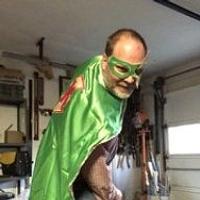Share your craft projects
Make new craft buddies
Ask craft questions
Blog your craft journey

HokieKen
8317 posts
and
56 followers
in about 3 years
in about 3 years
A Handplane Rehab #6: Stick a Fork in it!
This is
part 6
in a
6 part
series:
A Handplane Rehab
Well, a mere 6 months after starting this series, I'm finally ready to wrap it up…
So let's dive right in! When last I left off, I had finished repairing the tote. So now it was time to finish the tote and knob. The tote had been sanded back so the original film finish was removed before I did the horn repair. I just sanded it up through some higher grits stopping at 400. The knob still had the film finish so I sanded it back. I still do knobs the same basic way I detailed in this old blog post except I have found that I prefer to work on it on my lathe rather than on the drill press. Better speed control and it's just more comfortable.
So let's dive right in! When last I left off, I had finished repairing the tote. So now it was time to finish the tote and knob. The tote had been sanded back so the original film finish was removed before I did the horn repair. I just sanded it up through some higher grits stopping at 400. The knob still had the film finish so I sanded it back. I still do knobs the same basic way I detailed in this old blog post except I have found that I prefer to work on it on my lathe rather than on the drill press. Better speed control and it's just more comfortable.

I have also found that using a flanged tee-nut instead of hex nuts lets me chuck up right against the flat and have the knob closer to the chuck and therefore less runout making it easier to sand.

So I sanded it up through the same grits to 400 like the tote. In contrast to how I've always finished the knobs and totes on my planes, I was seduced by the shiny side via Sansoo22's finished pieces ;-) Until now, all of my planes have just had the wood oiled and waxed as shown in the blog post I linked earlier. However I decided to go a different route on these. Sansoo uses a poly and finish wax schedule. But I wanted something with a little less gloss but also something that enhanced the wood on this plane.
So after a little research, I decided to give it a go with a modified French Polishing schedule. I am very happy with how the finish ended up on these so I'm going to give the details below. Note that the below details how it was applied to the tote specifically. The schedule was the same for the knob but I applied the shellac on the lathe running at slow speed rather than rubbing it on.
- Three coats of shellac at a 3# cut. Let cure overnight.
- After third coat, wet sand with mineral spirits at 600 grit until finish feels smooth. It may look duller in some areas but that's okay at this point. The goal here is fill the grain.
- Apply 2 coats of 2# cut shellac and let cure overnight.
- Wet sand with mineral spirits at 800 or 1000 grit. Sand lightly. Just enough to denib and level out the surface. Finish should feel smooth and appear even. If not, repeat 2# coats and wet sand until it is.
- After sanding, blow clean with compressed air (or use tack cloth if you prefer) and wipe lightly with denatured alcohol.
- Make a French Polishing pad with a wadding of wool the size of a large marble for the center and a clean, lint-free cotton cloth wrapped around it. Pad should be small enough to get into tight corners on the tote but as large as possible while doing so. When tightly wound, pad should make a ball of 1/2 to 3/4 inch diameter. Apply 2# shellac to the wool center so it's wet but not saturated. When banging pad on back of hand, only a trace amount of shellac should come through cotton outer layer onto hand. Put two drops of mineral or olive oil on pad, applied directly to outer layer, to reduce friction.
- Rub shellac onto wood in tight circular motion moving quickly and never pausing. If you see application being less obvious, stop and add some shellac to the center wadding. If it starts to get harder to move the pad, add another drop of oil to the surface. Continue to apply to full surface until it looks even and has a deliberate "wet" look. This probably takes 5-10 passes over the whole part to complete.
- Add 3 or 4 drops of DNA to the surface of the pad and wipe with the grain in fast, light passes. NEVER let the pad sit in a spot on the wood. It must be in continuous motion. This step is to remove any residual oil from the surface of the shellac and to even out any swirl marks from application. Repeat until finish looks smooth and streak free. Usually 1 or 2 passes over the part are sufficient. Let cure overnight.
- Repeat previous step until finish builds and is streak free and even. Focus each coat on areas that appear duller. I ended up doing 5 coats as detailed using the 2# cut. Some instructions recommend upwards of 20 coats. Do what looks and feels right!
- After final coat of 2# shellac applied as above let finish cure for 3 days then wet sand lightly with 1200 grit using mineral spirits. This is just to denib and lower any high areas of the finish. Don't sand any more than necessary. Blow clean after sanding and wipe lightly with DNA with the grain.
- Mix a 1# cut of shellac and put a new cotton cloth on your center wadding. Apply 1# cut same as before using the pad and oil to reduce friction. Do not wipe with DNA after this coat. Let cure overnight.
- Before starting each subsequent coat of 1# shellac, rub down with a second pad containing only a few drops of DNA. This is after the previous coat has cured overnight and any entrained oil should have risen to the surface. The purpose is to remove residual oil. Wipe pad with the grain and in constant motion. NEVER let it sit in one spot.
- Do 3 coats of 1# shellac and let the final coat cure for 3 days.
- If it looks and feels good, you're done! If not, wet sand lightly to even out any high spots and repeat 1# coats as many times as necessary.
- To knock the sheen down slightly after shellac is fully cured, apply a coat of paste wax with 0000 steel wool.
At least that's how I think I remember doing it… I kinda winged it. Here's a good write up on the French Polishing method in much better detail. Derive your own recipe from there
Here are some in-process shots during the finishing stage.



Enough about the wood! Moving on to the lever cap… After making the wood glossy and the brass and steel all shiny, the lever cap just wasn't going to do in its current condition:

So, I wire brushed it and polished it up:

But in the process, I lost the paint in the recess. So, I masked it up and shot some of the red paint I used for the frog on it covering the recess and the raised letters:

Then I masked it back up to prevent marring the polished surface and used some micro-mesh sanding sticks to remove the paint from the raised letters.


And done:

And that pretty much sums it up
So we went from the before:

To the after:




So she's pretty but is she useful?
Well, not at first :-( I was getting this:

I initially thought my chipbreaker wasn't doing its job properly and I needed to go back to work on it. But then when I removed the blade/chipbreaker the clog fell out. It wasn't stuck on the chipbreaker but instead the mouth was too tight. Then I remembered that I put the frog on way back after painting so I wouldn't misplace it but hadn't actually set the position. It was set a bit too far forward. So, I moved it back so the blade bed was flush with the ramp at the back of the mouth and put the cutter assembly back in. After a few swipes and a couple of taps on the lateral lever, voila



Full width shavings in short order. No, those aren't the gossamer thin shavings you usually see when somebody is showing off their plane. But this big boy is no smoother and he don't eat salad! I set it for about a .008" cut which is about how I like my jointers set. They aren't scrubbing anything so they don't need a real big bite. But I don't want to take 100 passes before I get a face fully flattened either so it needs to take a big enough bite to do that efficiently. And it'll get followed up with a smoother to do the final surfacing so a little tearout or edge tracks can be dealt with.
So there we are. This series ended up being a lot longer than I anticipated but at least I got my annual series done before Thanksgiving! My intention was to supplement my original series on rehabbing planes so hopefully these entries are helpful with some things that weren't covered previously. Thanks for reading and comments and questions are always welcome. And I constantly learn new and better ways to do parts of of plane rehabs so by all means, if you have suggestions on how I can do something better or easier, let me know!
6 Comments
nice restoration kenny.
working with my hands is a joy,it gives me a sense of fulfillment,somthing so many seek and so few find.-SAM MALOOF.
Ah, to see a nice blog series again! Nice job, Kenny!
Don't anthropomorphize your handplanes. They hate it when you do that. - OldTools Archive -
Very nice restoration..................works great and looks great.............Jim
Cheers, Jim ........................ Variety is the spice of life...............Learn something new every day
Great write up. I appreciate the info! Makes me feel more confident about picking up eBay planes and working to spruce them up!
Ryan/// ~sigh~ I blew up another bowl. Moke told me "I made the inside bigger than the outside".
talk about plane porn WOW nice blog Kenny GR8 JOB :<))))
*TONY ** Denver * ALWAYS REMEMBER TO HAVE FUN
Nice write up Kenny - I think I missed this one the first time around.














